
In a neat little neighborhood in Venice, Calif., there’s a block of squat, similar homes, filled with mortals spending their finite days on the planet eating pizza with friends, blowing out candles on birthday cakes, and binging late-night television. Halfway down the street, there’s a cavernous black modern box. This is where Bryan Johnson is working on what he calls “the most significant revolution in the history of Homo sapiens.”
[time-brightcove not-tgx=”true”]Johnson, 46, is a centimillionaire tech entrepreneur who has spent most of the last three years in pursuit of a singular goal: don’t die. During that time, he’s spent more than $4 million developing a life-extension system called Blueprint, in which he outsources every decision involving his body to a team of doctors, who use data to develop a strict health regimen to reduce what Johnson calls his “biological age.” That system includes downing 111 pills every day, wearing a baseball cap that shoots red light into his scalp, collecting his own stool samples, and sleeping with a tiny jet pack attached to his penis to monitor his nighttime erections. Johnson thinks of any act that accelerates aging—like eating a cookie, or getting less than eight hours of sleep—as an “act of violence.”
Johnson is not the only ultra-rich middle-aged man trying to vanquish the ravages of time. Jeff Bezos and Peter Thiel were both early investors in Unity Biotechnology, a company devoted to developing therapeutics to slow or reverse diseases associated with aging. Elite athletes employ therapies to keep their bodies young, from hyperbaric and cryotherapy chambers to “recovery sleepwear.” But Johnson’s quest is not just about staying rested or maintaining muscle tone. It’s about turning his whole body over to an anti-aging algorithm. He believes death is optional. He plans never to do it.
Outsourcing the management of his body means defeating what Johnson calls his “rascal mind”—the part of us that wants to eat ice cream after dinner, or have sex at 1 a.m., or drink beer with friends. The goal is to get his 46-year-old organs to look and act like 18-year-old organs. Johnson says the data compiled by his doctors suggests that Blueprint has so far given him the bones of a 30-year-old, and the heart of a 37-year-old. The experiment has “proven a competent system is better at managing me than a human can,” Johnson says, a breakthrough that he says is “reframing what it means to be human.” He describes his intense diet and exercise regime as falling somewhere between the Italian Renaissance and the invention of calculus in the pantheon of human achievement. Michelangelo had the Sistine Chapel; Johnson has his special green juice.
But when I showed up at Johnson’s house one Monday in August, I wasn’t really there to figure out if his elaborate age-defying strategies actually worked. I assumed that given my family history of cancer and personal fondness for pepperoni pizza, I probably won’t live long enough to find out. Instead, I spent three days observing Johnson to learn what a life run by an algorithm would look like, and whether the “next evolution of being human” would have any real humanity at all. If living like Johnson meant you could live forever—a big if!—would it even be worth it?
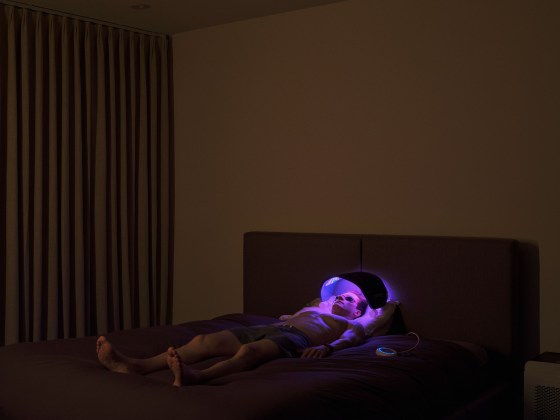
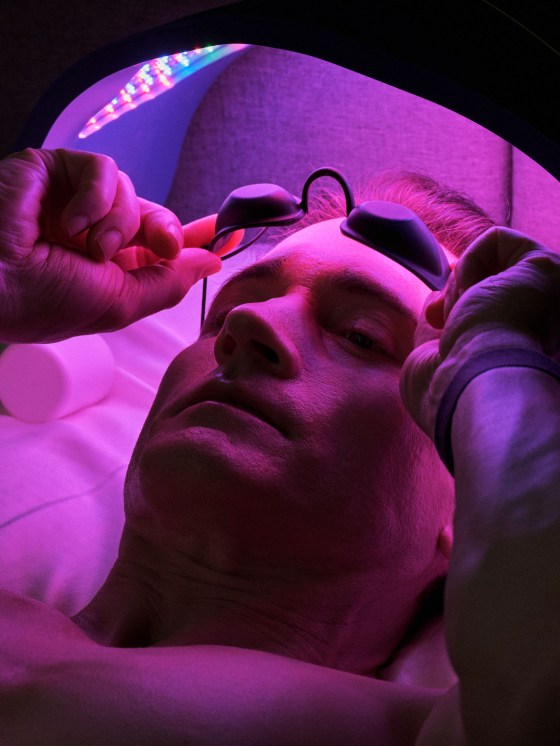
Kate Tolo opens the door to Johnson’s house and welcomes me inside. Tolo, a 27-year-old former fashion strategist who is originally from Australia, is Johnson’s chief marketing officer and most loyal disciple. Two months ago, she became the first person aside from Johnson to commit to Blueprint, making her the first test of how Blueprint works on a female body. Tolo is known as “Blueprint XX.”
The home is beautiful and devoid of clutter, with floor-to-ceiling windows looking out on the pool and lush greenery outside. It reminds me of an Apple Store in a jungle. Tolo offers me a little bowl of special chocolate, which had been “un-dutched,” stripped of heavy metals, and sourced only from regions with high polyphenol density. It tastes like a foot. She also makes me a juice-like concoction that contains chlorella powder with spermidine, amino complex, creatine, collagen peptides, cocoa flavanols, and ceylon cinnamon. Tolo and Johnson call it the Green Giant, but it looks almost black, like the stuff that washes off a duck after an oil spill. She manages to mix it without getting any of the dark sludge on her immaculate white jumpsuit. “It moves through some people’s digestive system faster than others,” she chirps, gesturing to the nearby bathroom. I take a tentative sip. It tastes like Gatorade, but sandy.
Johnson walks into the room, wearing a green T-shirt and tiny white shorts. He has the body of an 18-year-old and the face of someone who had spent millions attempting to look like an 18-year-old. His skin is pale and glowing, which is partly because of the multiple laser treatments he’s done, and partly because he had no hair on his entire body. The hair on his head is “not dyed,” Johnson says, but he does use a “gray-hair-reversal concoction” which includes “an herbal extract” that colors the hair a darkish brown. He gestures to my Green Giant, and then toward the bathroom. “Did you warn her?” he asks Tolo. I pretend to take another sip.
The next day, Johnson walks me through his morning routine, step-by-step. He woke up at 4:53 a.m, but delayed most of his routine until I arrive at 7 a.m. to observe him. His bedroom has almost nothing in it: no photos, no books, no television, no glass of water, no phone charger, no chair with piled-up clothes he tried on once, no dry cleaning he meant to put away, no towels, no mirror, no nothing. “I only sleep in here,” he says. “No work, no reading.” The only two objects in the room besides his bed are a laser face-shield he uses for collagen growth and wrinkle reduction, and the device he wears on his penis while he sleeps to measure his nighttime erections. “I have, on average, two hours and 12 minutes each night of erection of a certain quality,” he says. “To be age 18, it would be three hours and 30 minutes.” Nighttime erections, he says, are “a biological age marker for your sexual function,” one that also has implications for cardiovascular fitness. The erection tracker looks like a little AirPods case with a turquoise strap, like a purse worn by a penis. (No penises were viewed in the reporting of this article.)
When Johnson wakes up and removes the device, he weighs himself on a scale that uses “electrical impedance” to measure his weight, body-mass index, hydration level, body fat, and something called “pulse wave velocity,” which he explained but I didn’t quite grasp. “I’m in the top 1% of ideal muscle fat,” he says. Then he turns on his light-therapy lamp (which mimics sun exposure) for two to three minutes to reset his circadian rhythm. He takes his inner-ear temperature to monitor changes in his body, and starts off with two pills of ferritin to boost his iron, along with some vitamin C. He washes his face, uses a cream to prevent wrinkles, and puts on a laser light mask for five minutes, with red and blue lights designed to stimulate collagen growth and control blemishes. By this time, it’s typically about 6 a.m., and Johnson walks downstairs to start his day.
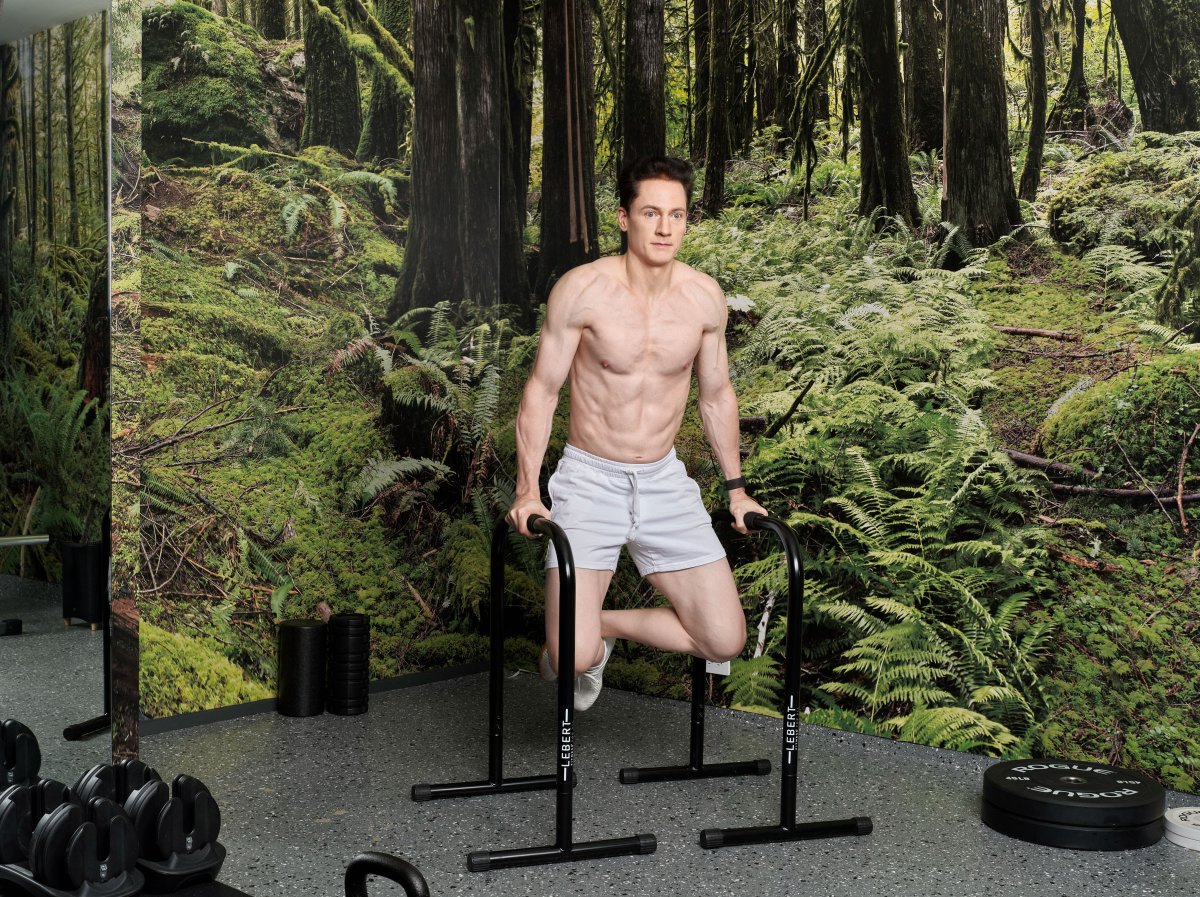
The Blueprint supplement regimen is arranged on Johnson’s kitchen counter, organized from left to right. He begins with eye drops for his pre-cataracts, then uses a little vibrating device against the side of his nose to stimulate a nerve that apparently helps his eyes create tears. Johnson makes his Green Giant, then starts taking more pills in between sips of dark-green sludge. “It’s what my body has asked for,” he says. Does he ever miss coffee, even a little? “I love coffee, it’s so fun,” he says. “It’s an addictive escalation drug for me.”
At this point, he begins doing special exercises to increase his grip strength. Then he heads to his home gym—decorated with a floor-to-ceiling wallpaper photograph of a forest—and starts an hour-long routine. Johnson can leg-press 800 lbs., but his daily workout isn’t much more advanced than something you’d see from a very enthusiastic guy at the gym: a series of weights, planks, and stretches. He does this seven days a week; he adds on a high-intensity workout three days a week. Occasionally, during these high-intensity workouts, he’ll wear a plastic mask to measure his VO2 max, or the maximum rate of oxygen consumption during physical exercise. Johnson’s VO2 Max is in the top 1.5% of 18-year-olds, he says.
After his workout, Johnson eats a meal of steamed vegetables and lentils that have been blended until they resemble a mush the color of a sea lion. He and Tolo don’t name their meals “breakfast,” “lunch,” or “dinner.” They call them “first meal,” “second meal,” and so on. This is first meal. He offers me some “nutty pudding,” which is made from macadamia-nut milk, ground macadamia and walnuts, chia seed, flaxseed, Brazil nuts, sunflower lecithin, ceylon cinnamon, and pomegranate juice. It’s the color of a pencil eraser and tastes a little dusty, but it’s not too different from a vegan yogurt, if you like that sort of thing.
Johnson insists all this is about something much bigger than getting ripped and maintaining a youthful glow. “Most people assume death is inevitable. We’re just basically trying to prolong the time we have before we die,” he says. Until now, he adds, “I don’t think there’s been any time in history where Homo sapiens could say with a straight face that death may not be inevitable.”
Experts strongly disagree. “Death is not optional; it’s written into our genes,” says Dr. Pinchas Cohen, dean of the Leonard Davis School of Gerontology at the University of Southern California. Cohen emphasizes that living longer in the future is certainly possible: over the course of the 20th century, human life expectancy rose from around 50 to more than 80. But living forever is not. “There’s absolutely no evidence that it’s possible,” Cohen says, “and there’s absolutely no technology right now that even suggests that we’re heading that way.”
“If you want immortality, you should go to a church,” adds Dr. Eric Verdin, CEO of the Buck Institute for Research on Aging. “If I believed even a little bit that it would be possible, I would be excited. It’s a pipe dream.” Verdin isn’t just skeptical of Johnson’s claims that he can achieve immortality; he’s skeptical of his claims of age-reversal altogether. “He professes to make everything transparent, but as a scientist it’s really impossible to understand the tools he’s using to assess his age,” Verdin says, adding that the Buck Institute reached out to Johnson to collaborate on some research, but never heard back. Johnson’s lack of interest in collaboration with independent scientists made Dr. Verdin even more skeptical. “I think if he wants to convince all of us that what he’s doing is valid, then he’s going to have to accept being challenged by colleagues,” he says. (Johnson doesn’t remember ignoring Verdin’s invitation, and says that he and Verdin have recently exchanged friendly emails.)
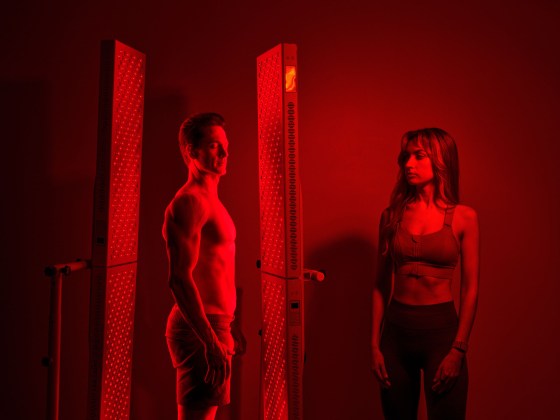
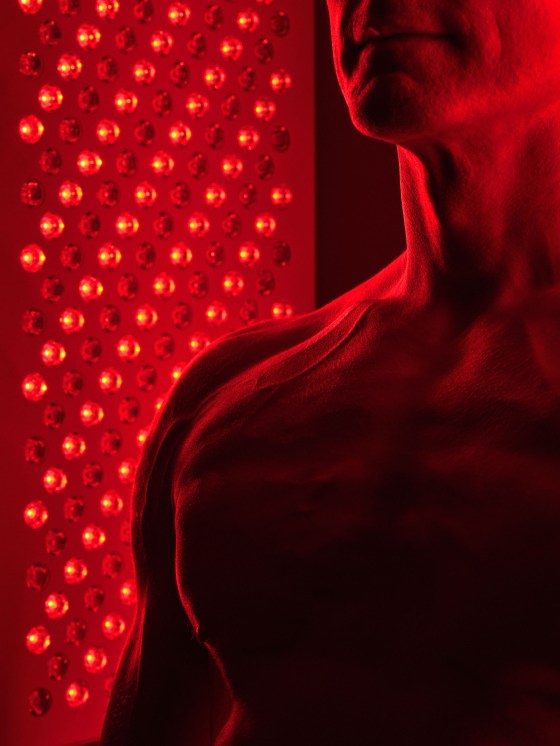
Some scientists do believe that limited age-reversal is possible. In still controversial and contested work, researchers at Harvard Medical School have claimed they’ve rejuvenated older mice, and are currently testing whether the aging clock can be turned back in human skin and eye cells. But those experiments are being done according to established scientific conventions. Johnson, in contrast, has made himself a human guinea pig, adopting nearly every age-related treatment at once and seeing what works.
It’s not just that medical professionals are skeptical of Blueprint’s ability to achieve immortality. They’re not even convinced Johnson’s routine is particularly healthy. Dr. Nir Barzilai, the director of the Institute for Aging Research at the Albert Einstein College of Medicine in New York City, met Johnson in May, at the annual retreat for the Academy for Health & Lifespan Research. Barzilai recalls that when Johnson showed up, the doctors present were concerned. “He looked sick. He was pale. I don’t know what he did with his face,” Dr. Barzilai says, adding that he was alarmed by Johnson’s lack of fat, which plays an important role in the body. “All these MDs, we all kind of agreed that he didn’t look so great.”
Barzilai also has serious reservations about Johnson taking so many supplements and treatments at once, warning that all the different pills could interact with one another in dangerous ways. “What he’s doing hasn’t proven to be safe, because some of the treatments he’s taking are actually antagonizing to each other,” he says, adding that doctors normally research the effects of one drug at a time, rather than the cumulative effects of more than 100 pills at once. “Even if it works for him, how do you know it works for you?” Barzilai says. Blueprint, he adds, is “not an experiment that we accept as scientists or doctors.”
Johnson did not make his own doctors available for an interview, nor did he provide details about his team. But he intends to bring Blueprint to the masses. Johnson puts all of his biological measurements online—from his resting heart rate to his plaque index to images of his intestines taken with a “small bowel camera”—and his YouTube videos about his exercise regimen and therapeutic experiments have been viewed by millions of people. Roughly 180,000 people signed up for his newsletter in the first five months, Tolo says. Blueprint’s first commercial product, sold on his website, is an allegedly cholesterol-reducing olive oil, sold in a black box emblazoned with a red-lit photo of Johnson and the slogan “Build your autonomous self.” Fifteen percent of Johnson’s daily diet consists of this olive oil. Two 25 oz. bottles cost $75. Tolo says they’ve sold out.
As Johnson, Tolo and I settle in to eat our “first meal” on his massive rust-colored couch, Johnson gestures to a bookshelf full of biographies: Ben Franklin, Harry Truman, Winston Churchill, Napoleon. “I have a relationship with the 25th century more than I have a relationship with the 21st century,” he says. “I don’t really care what people in our time and place think of me. I really care about what the 25th century thinks.”
Artificial intelligence “is clearly the most significant event in this part of the galaxy,” he says. “What is the equivalent response for humans to have to AI?” Given the looming AI revolution, Johnson argues that outsourcing the management of the body to an algorithm is the ultimate form of human-AI “alignment.” If everything from marketing to legal research to retail will soon be optimized by algorithms, why shouldn’t algorithms run our bodies as well? Johnson argues that automating the physical body is a form of evolutionary adaptation to what he believes is an inevitable, AI-dominated future.
But all this talk about the scope of history, and the march of technology, and the benefits of un-dutched chocolate seemed to be missing something, I say. Aren’t humans more than just brains and meat? Isn’t there some other ineffable element that makes us human: the feeling of watching your toddler play in a lake, the joy of popcorn with girlfriends at the movie theater, the grief of losing a family member, the frustration at a lost earring? Surely, there must be more to living than simply maintaining adequate oxygen in your spleen.

He doesn’t see it that way. “Whether we’re talking about falling in love, or having sex, or going to the baseball game, you’re talking about biochemical states in the body,” Johnson says. “You can remove everything and just say, ‘I’m experiencing this kind of electrical activity in my body and these kinds of hormones.’ We have a whole bunch of ideas about what it means to exist, we have all these ideas about what is happiness, and other things. We’re walking into a future where we no longer have control,” he continues. Which means “we are willing to divorce ourselves from all human custom. Everything: all philosophy, all ethics, all morals, all happiness.”
I try another approach. Let’s say you’re right, I ask Johnson. What if you do live forever? That means you’d outlive everybody you’d ever known on the planet. You’d watch your children and grandchildren and all your friends die before you. What would that be like? Is a life without the people you love worth living?
Johnson says that question reminds him of “senior night” before graduating from high school. “We say goodbye, we have been together all these years, and we’re probably not going to see each other again,” he says. “At every stage in life, we move through these transition states of relationships and new experiences,” he continues. “And at every stage, you could certainly pose that question, because the circumstances are going to change. Is it worth it to carry on?”
It strikes me as a weird way to answer a question about watching his own children die, but I turn to Tolo, who was silently eating her nutty pudding in a different corner of the couch. I ask her what she thought about the possibility of watching everyone she loves die before she does. It doesn’t seem like she’s considered this. “Hopefully they wouldn’t,” she says. “I really hope that as many people as possible can come along that journey.”
Johnson chimes in again. “I think your question reflects Homo sapiens for the 21st century,” he says. “The underlying assumption is, they have roughly 70 years of life. That’s their starting frame: I’m going to die soon, and I can’t do anything about it. So I’m optimizing in this window of time… If you change the frame, and death is not inevitable, none of the previous practiced thought patterns work.”
My 21st century Homo sapien brain was not convinced. Johnson seemed to suggest that for humans to survive in an AI-aligned future, they may need to sacrifice part of what makes them human in the first place. I thought of Tuck Everlasting, the 1975 children’s novel about an immortal family whose inability to age sets them apart from the world, adrift from the life of everyone they meet, forever alone.
I left Johnson’s house and drove to the DoubleTree hotel in Marina Del Rey. The woman at the front desk handed me a chocolate chip cookie, as they usually do at DoubleTrees (which is why I stay there). My rascal brain wanted it. But it was an act of violence that would accelerate my inevitable death. I abandoned it on the counter and took my Blueprint-approved dinner—steamed broccoli, cauliflower, and lentils, with $75 dollar olive oil and absolutely no flavor—up to my room.
Johnson wasn’t always like this. He grew up in a small Mormon community in Utah. His grandfather owned a farm with horses, and Johnson and his four siblings spent most of their time outside, helping to harvest alfalfa and corn. Johnson served his Mormon mission in Ecuador, then went to Brigham Young University, followed by business school at the University of Chicago. He got married, had three children, and in 2007 he founded Braintree, a payment-processing company. Braintree acquired Venmo five years later. In 2013, the combined entity was sold to PayPal for roughly $800 million. Johnson walked away with more than $300 million.
Despite his financial success, Johnson recalls this as a painful time. He says he fell into a deep depression in 2004 and stayed there for 10 years. He was overwhelmed by building his company while raising three young children. Medication and therapy didn’t help. He was 50 pounds overweight and miserable, he says.
Within a year of selling his company, Johnson ended his marriage and left the Mormon church. In 2014, he plowed $100 million into the creation of the OS Fund, which invests in companies working in what Johnson calls the “programmable physical world”—his term for companies that use AI and machine learning to develop new technologies for therapeutics, diagnostics, and synthetic biology. In 2016, Johnson founded Kernel, a neurotechnology company that uses a specially designed helmet to measure brain activity. Its goal is to detect cognitive impairment at the earliest stages; for now, the company is looking for biomarkers for psychiatric conditions. It can also be used, as a fun side hobby, to measure the age of his brain.
One day during my visit, we drive to the company’s offices, which are about 20 minutes from Johnson’s home. Even though his mission in life is to “not die,” he still drives himself around LA in an electric Audi. (Extremely slowly.) Before he pulls out of his driveway, he utters his pre-driving mantra to himself: “Driving is the most dangerous thing we do.” Johnson is aware that his singular focus on living forever might make an accidental death somewhat embarrassing. “What would be more beautiful irony than me getting hit by a bus and dying?” he says.
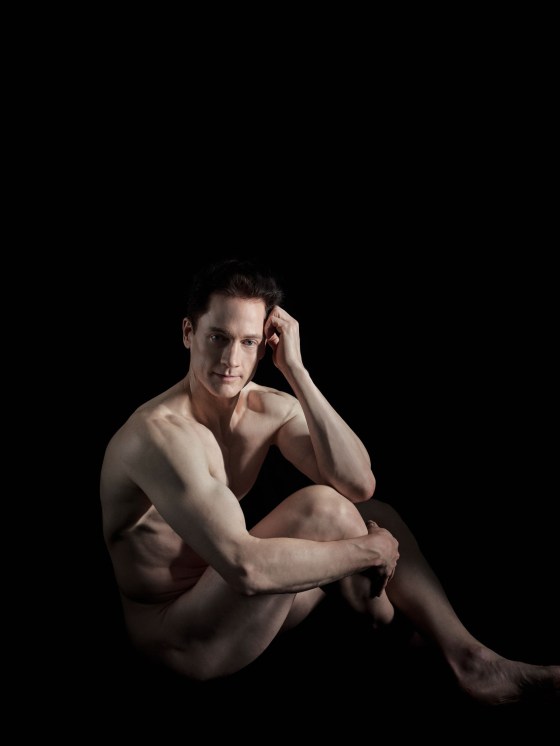
In Kernel’s open-plan office, I’m brought into a small room, where a technician fits my head with what looks like a ski helmet with dozens of circular probes inside. I’m instructed to sit and watch a screensaver-type video of soft crystalline shapes morphing into each other. Later that day, my results appear in my email. It tells me that although I am 34, my brain age is 30.5.
On the way home, Johnson utters his pre-driving mantra again before inching through the streets of LA at about 16 m.p.h. As he’s explaining again why Blueprint is “the most significant revolution in the history of Homo sapiens,” a black Chevy truck pulls out of a Trader Joe’s parking lot. He swerves to avoid it, barely taking a breath before returning to comparing himself to Magellan and Lewis and Clark. “I’m not a biohacker. I’m not an optimization person,” he tells me. “I’m an explorer, about the future of being human.”
Even futuristic humans were mere mortals once. Tolo first reached out to Johnson in 2016, when she was working in fashion in New York City. The AI revolution was beginning to come into view. “I felt so strongly that the only way we could proceed as species would be to kind of latch ourselves onto AI,” she says. She saw a quote from Johnson in a tech newsletter, advocating for humans to “merge with AI,” and decided she wanted to work for him. After years of entreaties, a job finally opened up, and Tolo took a title and pay cut to become Johnson’s assistant at Kernel. “We’d spend hours in his office, just chatting about the future of humanity,” she says.
When she first started working for Johnson, Tolo was a typical twentysomething. She drank alcohol and milky lattes, ate fast food, and stayed up too late dancing with her friends. But early this year, she and Johnson began discussing whether she should try Blueprint as well, to see how the routine would affect a female body. Before committing, Tolo requested a 30-day trial period. That trial included committing to a rigorous sleep routine, adopting Johnson’s exact diet protocol, taking more than 60 pills a day, and doing 13 minutes of intense exercise and 39 minutes of moderate exercise every day. She also measured her ovulation and her menstrual cycle.
“When I was in my trial period, I would go out to brunch with friends, and I would bring my Blueprint food, and there is a bit of sadness,” Tolo says. “Because everyone else at the table is like, ‘Oh my God, this breakfast burrito is so good.’” Ultimately Tolo decided to commit to Blueprint for good. She concluded the health benefits outweighed the lifestyle costs. Tolo says her friends have adjusted to her Blueprint lifestyle. She’s moved her social life earlier in the day to protect her sleep schedule, and they’ve gotten used to her habit of bringing her own vegetable mush to restaurants. The decision, once made, was permanent. “It would also be the final decision in a way,” she says. “It’s like, I’m deciding to no longer decide again.”
Now, as Blueprint XX, she has given up “all the things that I’ve come to cherish in small ways about my life,” she says. She and Johnson think of themselves as a sort of futuristic Adam and Eve. They had even planned an Adam-and-Eve themed photoshoot to help people understand that they’re “talking about a revolution on the scale of the whole human race,” Johnson says. Even though Tolo is apparently as important to the future of humanity as Eve herself, she plated and served all the meals I ate on my visit, and, at least while I was there, seemed to do most of the dishes.
Johnson is currently single. His older son is serving a mission for the Mormon church, and his younger daughter is 13 and lives with her mother. So Johnson spends much of his time with his 18-year-old middle son, Talmage, who commits to the Blueprint diet, rest, and exercise routines, but skips the anti-aging therapies. He briefly donated blood plasma to Johnson in order to test whether it had a measurable impact on his father’s aging, but stopped once Johnson decided it didn’t work. Talmage, who is about to start his freshman year of college, says that he’s adopted many of his dad’s attitudes towards lifestyle and life extension. “The idea of having pizza is more painful than pleasurable for me,” he says.
Johnson says his lifestyle makes it very difficult for him to date, rattling off what he calls the “10 reasons why [women] will literally hate me.” The reasons include: eating dinner at 11:30 a.m., no sunny vacations, bed at 8:30pm, no small talk, always sleeping alone, and, of course, “they’re not my number one priority.”
Throughout my visit with Johnson, I could feel my rascal brain buzzing to life. Johnson venerates what he calls “the emergent self,” which is driven “more by computational guidance and less by human want.” And yet wanting, I thought, is what humans do. There is almost no experience more human than the experience of want. As I watched Johnson drink his immortality gruel and explain his religious commitment to bedtime, I was wondering: What did he want? Did he miss eating birthday cake? Staying up late dancing? Baseball games that stretch into long nights filled with hot dogs and beer? Johnson wanted an eternal life. But what is life without wanting?
There were so many things I wanted to do, even if I knew that each indulgence could bring me closer to death. I wanted to meet a friend for cocktails in Santa Monica. I wanted to snuggle into my hotel bed and watch And Just Like That, and I wanted to stay up too late texting my friends about it. I wanted to FaceTime my daughter, the one who had caused me to gain 30 happy pounds when I ate only butter pasta and cheese pizza for most of my pregnancy. I wanted to take the first plane home, even if it meant landing at 1 a.m. and getting four hours of sleep, so that I could be there when she wakes up and says “Up!” with the force of a commanding officer. I wanted eggs and bacon for breakfast. I didn’t want to stop wanting. Life’s too short.
With reporting by Leslie Dickstein

Post A Comment:
0 comments: